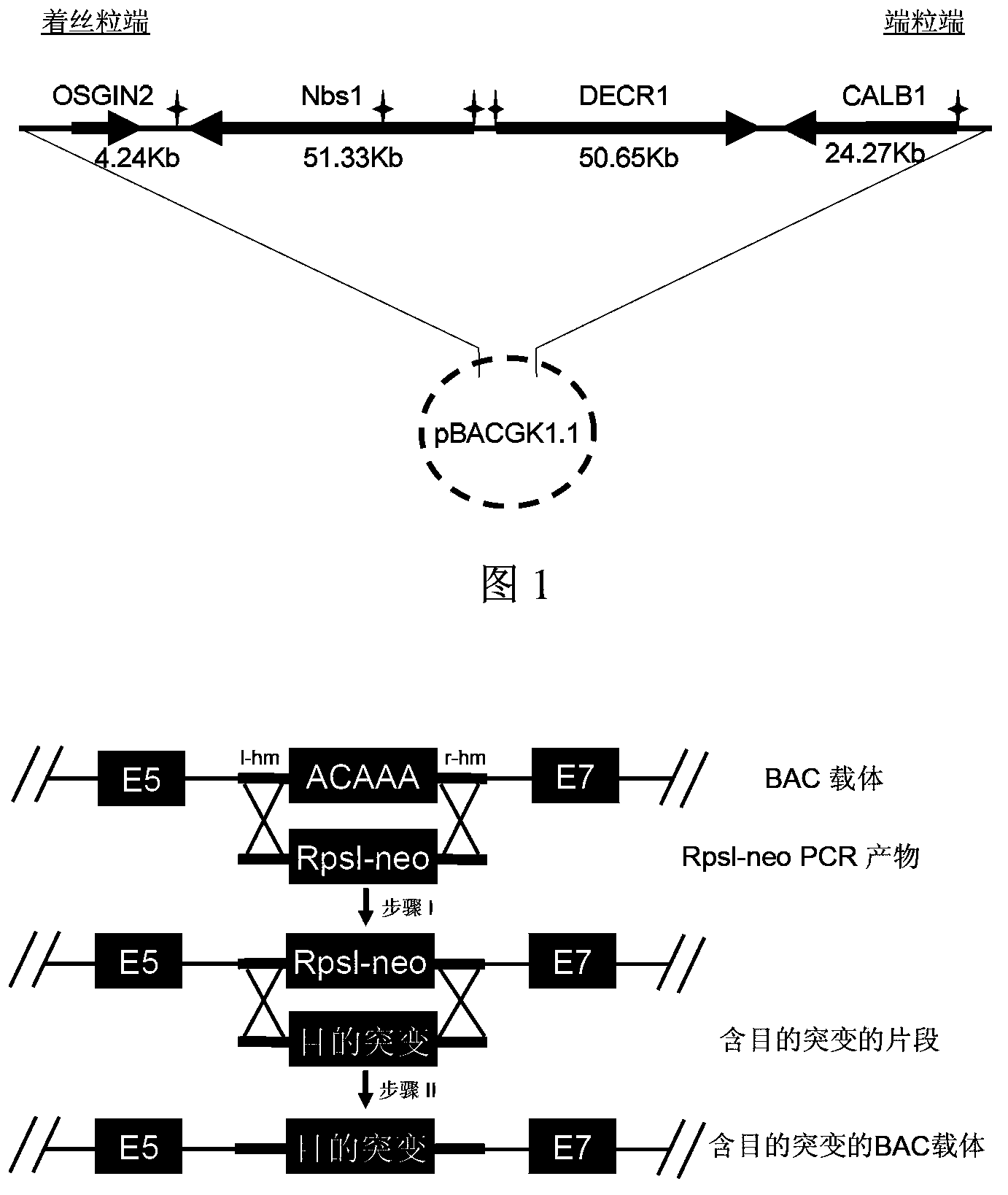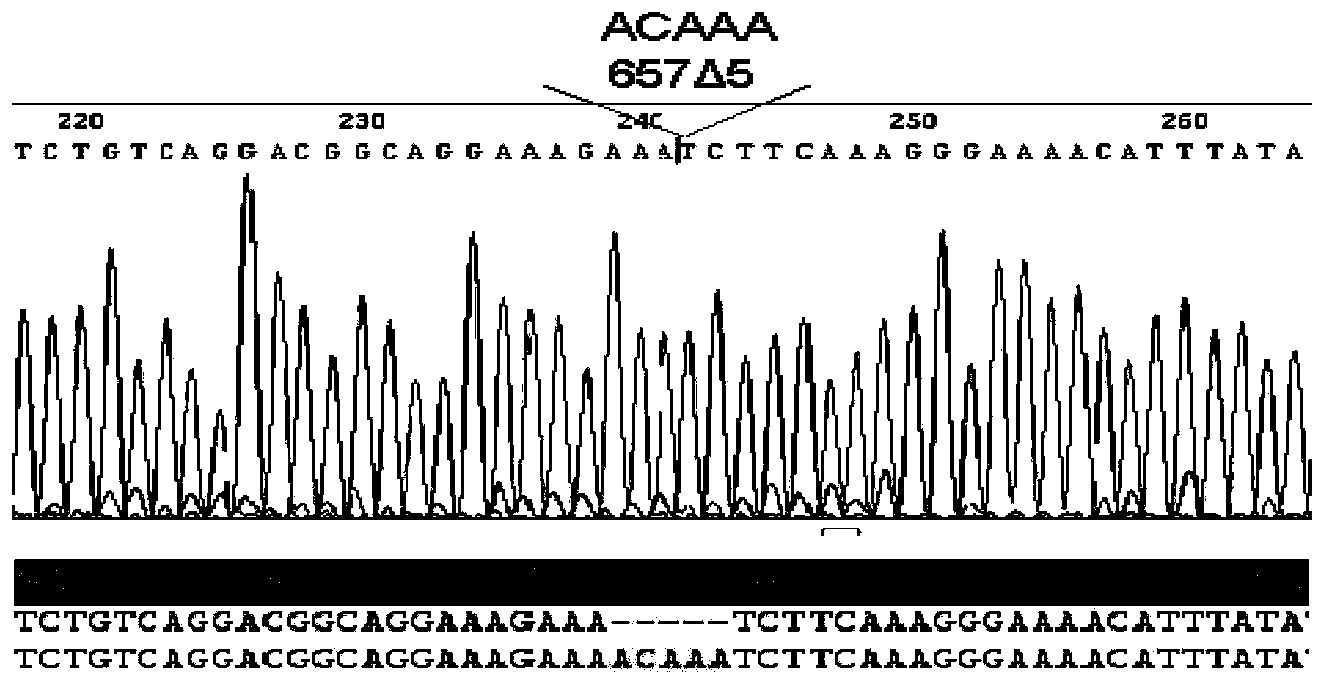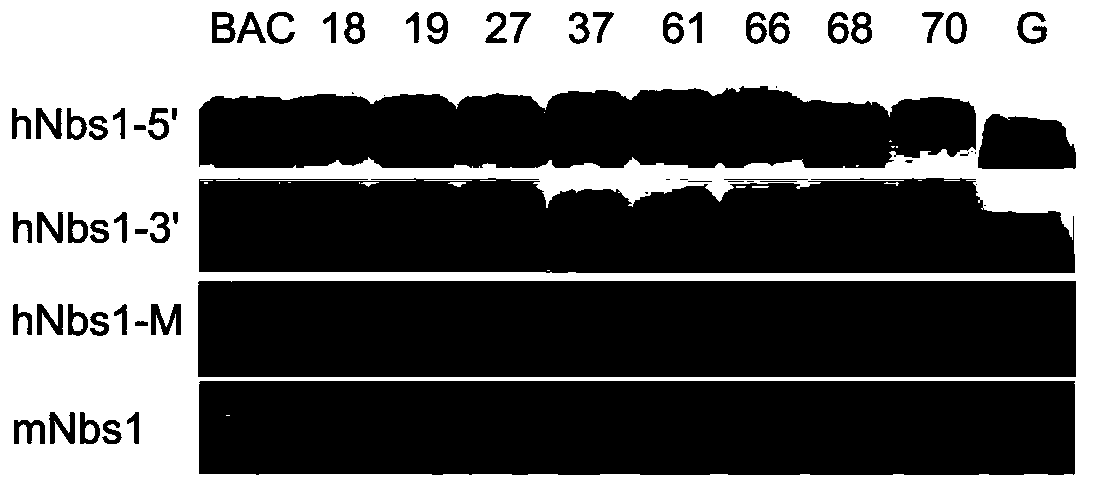Construction method and application of humanized mouse model
A humanized and sequenced technology, applied in the construction and application of humanized mouse models, can solve problems such as no background data, no key technologies, and no technical standards.
- Summary
- Abstract
- Description
- Claims
- Application Information
AI Technical Summary
Problems solved by technology
Method used
Image
Examples
Embodiment 1
[0089] Example 1: Query, order and PCR identification of human BAC clones.
[0090] By searching the Ensemble Genome Browser to determine the region of Nbs1 and its upstream and downstream DNA sequences of at least 50kb on the chromosome, and minimize the existence of other genes, the human BAC clone numbered CH17-246C15 was screened from the NCBI Clone DB Qualified (see Figure 1). Ordered BAC clones (CHORI) are stored in DH10B host cells and mailed with agar as a carrier. The strain was streak cultured, and expanded after inoculation. Then use 2 pairs of specific primers located at the 5' and 3' of the c.657del5 mutation site to carry out bacterial liquid PCR identification on the purchased BAC strains. The primer sequences are as follows:
[0091] hNbs1-657tF: TGTCACCTGCCACCATATTTCTAG (SEQ ID NO: 1)
[0092] hNbs1-657tR: CCGTAATCACAGCCATGATCACT (SEQ ID NO: 2)
[0093] PCR amplification conditions: 94°C for 5min, 35* (94°C for 30sec, 55°C for 30sec, 72°C for 30sec), 72°C ...
Embodiment 2
[0094] Embodiment 2: the construction of gene carrier
[0095] Step 1. Using the pRpsl-neo plasmid (donated by the Vector Group of the Institute of Model Animals, Nanjing University) as a template, the rpsl-neo fragment was obtained by PrimeSTAR high-fidelity PCR (TaKaRa), which contained: 1319bp rpsl-neo, c.657del5 mutation The 61bp homology arm (l-hm) at the 5' end of the site and the 61bp homology arm (r-hm) at its 3' end. The primer sequences are as follows:
[0096] hNbs1-657hF: CTCTTGATGAACCATCTATTGGAAGTAAAAATGTTGATCTGTCAGGACGGCAGGAAAGAAAGGCCTGGTGATGATGGCGGGATCG (SEQ ID NO: 3)
[0097] hNbs1-657hR:TTAGCTTATAACATAATTACCTGTTTGGCATTCAAAAATATAAATGTTTTCCCTTTGAAGATCAGAAGAACTCGTCAAGAAGGCG (SEQ ID NO: 4)
[0098] PCR amplification conditions: 95°C for 5min, 5* (98°C for 15sec, 55°C for 15sec, 72°C for 2min), 26* (98°C for 15sec, 65°C for 15sec, 72°C for 2min), 72°C for 5min, and keep warm at 4°C. The product fragment was 1441bp, and then subjected to agarose gel electrophores...
Embodiment 3
[0130] Example 3: Analysis of Nbs1 c.657del5 Transcriptional characterization of human Nbs1 in transgenic mice.
[0131] Step 1. Extraction and inversion of RNA from different tissues.
[0132] The 8-week-old mice were killed, and 10 kinds of tissues (colon, liver, spleen, heart, muscle, kidney, brain, testis, lung, thymus) were quickly taken and placed in 500ul RNAiso Plus (TaKaRa) with 0.5M NaOH Homogenize rapidly in solution with a tissue homogenizer (PT2100, Kinematica). The homogenate was extracted with 1 / 5 volume of chloroform, then an equal volume of isopropanol was added to precipitate the total RNA, the precipitate was washed with 75% ethanol, and dissolved in DEPC-H 2 O middle. Then determine the OD value and correct it, use RT reagent Kit (TaKaRa) reverse transcribed 1ug RNA to obtain cDNA.
[0133] Step 2: RT-PCR detection of transcription characteristics of human Nbs1.
[0134] Using cDNA as a template, two pairs of specific primers located at the 5' end an...
PUM
 Login to View More
Login to View More Abstract
Description
Claims
Application Information
 Login to View More
Login to View More - R&D
- Intellectual Property
- Life Sciences
- Materials
- Tech Scout
- Unparalleled Data Quality
- Higher Quality Content
- 60% Fewer Hallucinations
Browse by: Latest US Patents, China's latest patents, Technical Efficacy Thesaurus, Application Domain, Technology Topic, Popular Technical Reports.
© 2025 PatSnap. All rights reserved.Legal|Privacy policy|Modern Slavery Act Transparency Statement|Sitemap|About US| Contact US: help@patsnap.com



